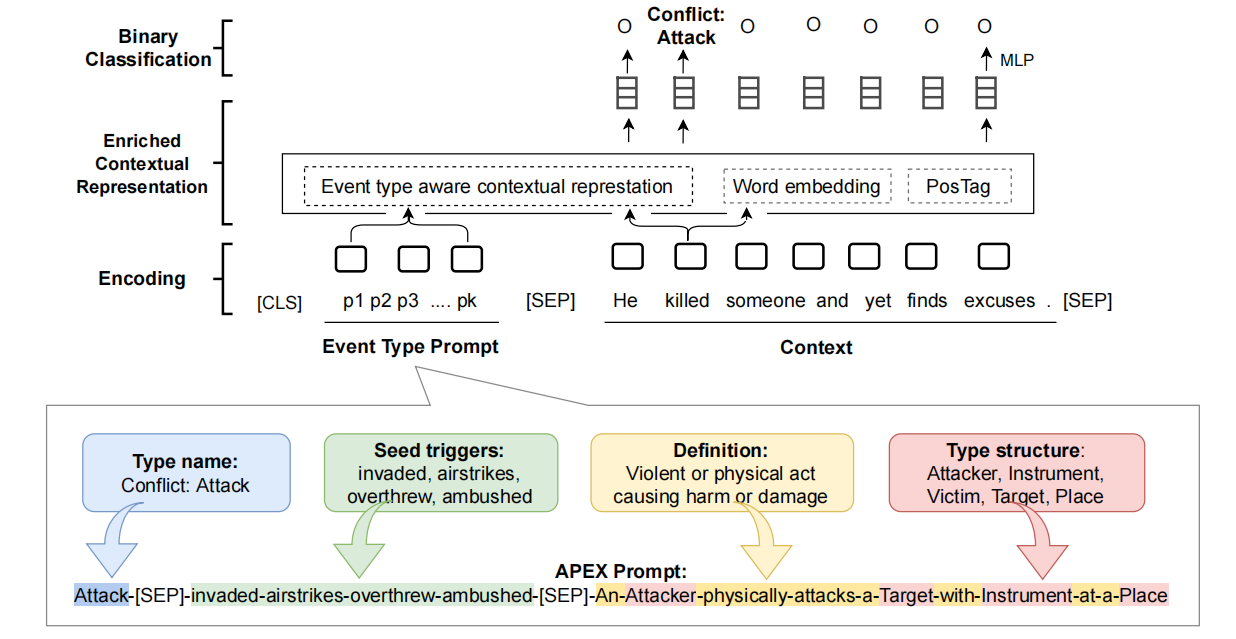The Art of Prompting: Event Detection based on Type Specific Prompts
Motivation
- 之前的研究表明prompt可以提高模型在事件检测方面的性能,包括
- 使用特定structure
- 使用每种事件类型特定的query
- 原型 trigger
- 这些尝试启发对不同prompt效果的探究
Settings
作者在3种setting下做了实验:
- Supervised event detection
- Few-shot Event detection
- 两个数据集\(D_{base}, D_{novel}\),前者规模大,后者小。后者用来作为第二个域。
- Zero-shot Event detection
- 只用第二个域的数据作为测试,不在\(D_{novel}\)上面fine-tune
Event Type Prompts
- Event Type Name
- 使用Event的名字作为prompt
- Definition
- 如 Attack:violent or physical act causing harm or damage
- Prototype Seed Triggers
- 在判断事件类别\(T\)时,选取\(K\)个trigger word,他们作为\(T\)的触发词的次数占他们出现总次数的比例最大,并连接起来。
- Event Type Structure
- 加入事件的参数
- Continuous Soft Prompt
- 参考经典论文 Prefifix-tuning: Optimizing continuous prompts for generation
- APEX Prompt
- 综合prompt,包含:event type name, seed triggers, and definition
- 如下图所示

A Unified Framework for Event Detection
-
Context Encoding
-
Sentence \(W={w_1,w_2,\dots,w_N}\)
-
event type prompt \(T={\tau _1^t, \tau _2^t,\dots,\tau _K^t}\)
-
拼接成一个序列
-
\[[CLS] \tau _1^t, \tau _2^t,\dots,\tau _K^t [SEP] w_1,\dots,w_N[SEP] \]
-
序列通过BERT得到对应的向量\(\mathbf{W},\mathbf{T}\)
-
-
Event Type Aware Contextual Representation
- 计算每个token的event type \(t\) aware contextual representation \(A_i^t=\sum_{j=1}^{|T|} \alpha_{ij} \cdot \mathbf{T}_j, \text{where } \alpha_{ij}=\cos(\mathbf{w}_i, \mathbf{T_j})\)
-
Event Detection
- \(\tilde{y}_i^t = U_o ([\mathbf{w}_i;\mathbf{A}_i^T;\mathbf{P}_i])\)
- \(\mathbf{P}_i\)是token i的pos编码向量
- \(U_o\)是预测事件检测的分类头
Experiments
| Method | Supervised ED | Few-shot ED | Zero-shot ED |
|---|---|---|---|
| State of the art | 73.3 | 35.2 | 49.1 |
| (a) Event Type name | 72.2 | 52.7 | 49.8 |
| (b) Defifinition | 73.1 | 46.7 | 45.5 |
| (c) Seed Triggers | 73.7 | 53.8 | 52.4 |
| (d) Event Type Structure | 72.8 | 50.4 | 48.0 |
| (e) Continuous Soft Prompt | 68.1 | 48.2 | - |
| Majority Voting of (a)-(e) | 73.9 | 52.1 | 48.7 |
| (f) APEX Prompt | 74.9 | 57.4 | 55.3 |
一个人没有梦想,和咸鱼有什么区别!


